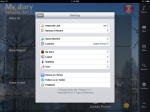Teen Hotlines: iOS iPhone/iPod (Free)
http://teenhealthandwellness.com/
Many of us wish for a good, thorough database of hotlines. The best-organized therapists that I know have a database somewhere, either on a spreadsheet or on their phone. However, I often find myself searching in session for a website or hotline number that best fits my particular client’s needs and demographic. For example, the last hotline I searched for was a suicide/help line for veterans. Adolescents are an excellent demographic, especially as cellphone and smartphone penetration among teens gets higher. (on a side note, this cellphone penetration lends itself to some interesting uses of text messaging as a therapy/homework tool.)
Teen Hotlines is one such resource; it actually has two main functions. First, it is designed as a comprehensive portable database of support and informational numbers for adolescents. There are many, many topics on their list, including resources for suicide, bullying, depression, sex, sexuality, domestic violence, and more. Now, I have not by any means vetted all of the organizations listed in this app, but (for example) the numbers listed under sexuality are free from references to unsubstantiated and genuinely harmful things like “reparative therapy.”
The app also functions as a gateway to the Teen Health and Wellness website, which is a resource with message boards, literature on a broad range of teen mental health issues. You’ll note upon going there that it asks for a login and mentions a “30 day free trial.” Obtaining access to the full site is a kind of unique process, as it is typically made available through local libraries, schools, or similar institutions. I was able to “join” via my local library membership (in fact, I learned about this app from a news post on my library’s homepage). From within the app, the “login” link opens the full website in Safari after obtaining your login info. I only had to enter my library card number once; the app remembers it; this is good, because I don’t want a teen in crisis to have to go through any extra steps to get the information. You can use the hotline portion of the app without a login or without interacting with the website at all.
The UI is easy enough to navigate, and the links to phone numbers work properly. Numbers are listed by category. One thing I like is that every time the app opens, there is a message suggesting that you skip the hotline and call 911 if you are in an immediate emergency or danger. In terms of security, this app doesn’t keep any information aside from library card or other login. However, calls will of course end up in the call log on the phone; given the delicacy of confidentiality issues with teens, you probably don’t want parents finding out sensitive information by accident.
- Opening screen with 911 instruction
- Partial list of categories
A tangential final tip: if a child has a deactivated iPhone that they are using as an iPod, it can still dial 911 just like any deactivated cellphone (but only if it has a SIM card in for AT&T or TMobile, as far as I know; deactivated phones on Sprint and Verizon should be able to call 911).
Content: 5/5 – a good reference list, no blatant missing categories, references appear to be appropriately neutral/nonjudgmental
User Interface/Experience – 4/5 – login process is a little clunky, and accessing the information on the website is extremely obscure unless someone at your school or library advertises it. No such problems if you are only using it as a hotline reference.
** Disclaimer: While some of these apps may be helpful to you, NOTHING that I review is a replacement for therapy services from a qualified, licensed psychotherapist. If you are reading this because you or someone you care for needs it for mental health reasons, get them live help ASAP. Also, if you haven’t yet, read A Few Words on Security, which contains tips on keeping your and your client’s smartphone data safe from unwanted eyes.









